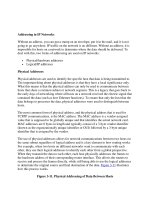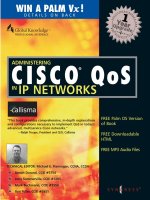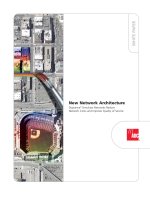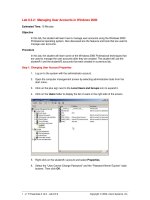Tài liệu Implementing Service Quality in IP Networks doc
Bạn đang xem bản rút gọn của tài liệu. Xem và tải ngay bản đầy đủ của tài liệu tại đây (1.42 MB, 354 trang )
Implementing Service
Quality in IP Networks
Implementing Service
Quality in IP Networks
Vilho R¨ais¨anen
Nokia Networks OY, Finland
Copyright 2003 John Wiley & Sons Ltd, The Atrium, Southern Gate, Chichester,
West Sussex PO19 8SQ, England
Telephone (+44) 1243 779777
Email (for orders and customer service enquiries):
Visit our Home Page on www.wileyeurope.com or www.wiley.com
All Rights Reserved. No part of this publication may be reproduced, stored in a retrieval
system or transmitted in any form or by any means, electronic, mechanical,
photocopying, recording, scanning or otherwise, except under the terms of the Copyright,
Designs and Patents Act 1988 or under the terms of a licence issued by the Copyright
Licensing Agency Ltd, 90 Tottenham Court Road, London W1T 4LP, UK, without the
permission in writing of the Publisher. Requests to the Publisher should be addressed to
the Permissions Department, John Wiley & Sons Ltd, The Atrium, Southern Gate,
Chichester, West Sussex PO19 8SQ, England, or emailed to , or
faxed to (+44) 1243 770620.
This publication is designed to provide accurate and authoritative information in regard
to the subject matter covered. It is sold on the understanding that the Publisher is not
engaged in rendering professional services. If professional advice or other expert
assistance is required, the services of a competent professional should be sought.
Other Wiley Editorial Offices
John Wiley & Sons Inc., 111 River Street, Hoboken, NJ 07030, USA
Jossey-Bass, 989 Market Street, San Francisco, CA 94103-1741, USA
Wiley-VCH Verlag GmbH, Boschstr. 12, D-69469 Weinheim, Germany
John Wiley & Sons Australia Ltd, 33 Park Road, Milton, Queensland 4064, Australia
John Wiley & Sons (Asia) Pte Ltd, 2 Clementi Loop #02-01, Jin Xing Distripark,
Singapore 129809
John Wiley & Sons Canada Ltd, 22 Worcester Road, Etobicoke, Ontario, Canada M9W 1L1
Wiley also publishes its books in a variety of electronic formats. Some content that
appears in print may not be available in electronic books.
Library of Congress Cataloging-in-Publication Data
R
¨
ais
¨
anen, Vilho.
Implementing service quality in IP networks / Vilho R
¨
ais
¨
anen.
p. cm.
Includes bibliographical references and index.
ISBN 0-470-84793-X (alk. paper)
1. Computer networks – Quality control. 2. Telecommunication – Quality control. 3.
TCP/IP (Computer network protocol) I. Title.
TK5105.5 .R345 2003
044.6
6 – dc21 2002191078
British Library Cataloguing in Publication Data
A catalogue record for this book is available from the British Library
ISBN 0-470-84793-X
Typeset in 11/13pt Palatino by Laserwords Private Limited, Chennai, India
Printed and bound in Great Britain by TJ International, Padstow, Cornwall
This book is printed on acid-free paper responsibly manufactured from sustainable
forestry in which at least two trees are planted for each one used for paper production.
Contents
Preface xi
Acknowledgements xv
List of Figures xvii
List of Tables xxi
Abbreviations xxiii
1 Drivers for the Adoption of Multi-service Networks 1
1.1 Customer Perspective 2
1.2 Network Operator Perspective 4
1.3 Service Provider Perspective 6
1.4 Summary 7
2 Service Quality Requirements 9
2.1 Services on the Internet 12
2.2 Definition of a Service 16
2.2.1 End user service versus provider-level services 18
2.2.2 About service instances and service events 20
2.2.3 Reference model for this section 22
2.3 Service Quality Estimation 23
2.3.1 Measures of end user experienced service quality 24
2.3.2 Recency effect 26
2.3.3 Psychological factors 27
2.3.4 Summary 28
2.4 Service Implementation Aspects 28
2.4.1 Choice of transport protocols 28
2.4.2 Throughput adaptability of services 29
2.5 Inherent Service Quality Requirements 30
2.5.1 Service quality characterizations in standards 30
2.5.2 Availability of service 33
Implementing Service Quality in IP Networks Vilho R
¨
ais
¨
anen
2003 John Wiley & Sons, Ltd ISBN: 0-470-84793-X
vi CONTENTS
2.5.3 Continuity of service 34
2.5.4 Delivery time end-to-end 35
2.5.5 Throughput 38
2.5.6 Support for continuous service data unit transmission 39
2.5.7 Reliability of service delivery 42
2.5.8 Support for variable transfer rate 44
2.5.9 Generic considerations related to service requirements 45
2.6 Service Quality Descriptors 47
2.6.1 Measurement-based determination of traffic profile 49
2.7 Summary 50
3 Network Mechanisms for Multi-service Quality Support 53
3.1 Introduction to Network Quality Support 54
3.2 Policing of Traffic at Ingress 58
3.3 About Layers 61
3.4 Types of Network Support for Service Quality 62
3.4.1 Capacity reservation 64
3.4.2 Differentiated treatment 65
3.4.3 Differentiation of service quality instantiation 67
3.4.4 Summary of generic network service quality support
mechanisms 68
3.5 Service Support in ATM 69
3.5.1 ATM service models 70
3.5.2 Summary of ATM service support 70
3.6 Service Support Models in Internet Protocol 71
3.6.1 Best effort service model 72
3.6.2 Controlled-load service support 74
3.6.3 Guaranteed QoS support 75
3.6.4 RSVP 76
3.6.5 Statistical QoS: DiffServ model 77
3.6.5.1 EF PHB 79
3.6.5.2 AF PHB group 81
3.6.5.3OtherPHBs82
3.6.5.4 Functions of a DiffServ router 82
3.6.5.5 Summary of DiffServ 83
3.6.6 Summary of IP QoS service models 83
3.7 Routing in IP Networks 85
3.7.1 On addressing 86
3.7.2 IP routing protocol-based methods 87
3.7.3 ATM overlays 88
3.7.4 Lower layer tunnels: MPLS 89
3.8 Link Layer Issues 90
3.8.1 Performance 92
3.8.2 A note on scheduling 93
3.9 Summary 94
CONTENTS vii
4 Traffic Engineering for Multi-service IP Networks 97
4.1 Traffic Engineering 98
4.1.1 Context of traffic engineering 100
4.1.2 The traffic engineering process 102
4.1.3 Obtaining performance data from the network and
analysing it 104
4.1.3.1 Traffic aggregate performance measurements 105
4.1.3.2 Obtaining data relevant for routing control 110
4.1.4 Performance enhancement 113
4.1.5 Scope of network optimization 116
4.2 IP Routing Control and Traffic Engineering 117
4.2.1 Optimizing routing based on service quality
characteristics 119
4.2.2 Traffic engineering using MPLS 120
4.2.2.1 DiffServ over MPLS 121
4.2.3 Traffic engineering using IP routing protocols 123
4.2.4 Summary 124
4.3 Configuration 125
4.3.1 Policy-based management 126
4.3.2 Policy-based management of DiffServ 129
4.3.2.1 Case study of policy-based management of
DiffServ 130
4.4 Summary 132
5 Mapping Service Requirements to Network Resources 133
5.1 Scope of this Chapter 135
5.2 ETSI EP TIPHON Reference Model 137
5.2.1 Architecture 137
5.2.2 QoS model 140
5.2.3 Summary 141
5.3 QBONE 142
5.3.1 Service support models 143
5.3.2 Summary 144
5.4 3GPP QoS Model 145
5.4.1 QoS model 146
5.4.2 Summary 148
5.5 Other Models 148
5.6 Utility-based Allocation of Resources 149
5.6.1 Summary 152
5.7 Generic Resource Allocation Framework 152
5.7.1 Signalling 154
5.7.2 Mapping of services onto network resources 156
5.7.3 Network quality support configuration
for DiffServ 160
5.7.4 End-to-end service quality budgets 163
viii CONTENTS
5.7.4.1 Delay 164
5.7.4.2 Delay variation 168
5.7.4.3 Packet loss rate 171
5.7.4.4 Packet loss correlation 172
5.7.4.5 Throughput 173
5.7.5 Optimization of resource allocation 174
5.8 Summary 176
6 Service Level Management Techniques 179
6.1 Models for Service Level Management 179
6.1.1 Areas of service level management 180
6.1.2 Layers of service level management 181
6.1.3 Models for managed data 183
6.2 Service Planning and Creation Process 184
6.2.1 Interests of the customer 184
6.2.2 Network operator viewpoint 187
6.2.3 Service definition 188
6.2.4 Reporting 190
6.3 Service Level Agreements 191
6.3.1 SLA and DiffServ 193
6.3.2 SLA contents 196
6.3.3 End user SLAs 197
6.4 End-to-end Services 198
6.4.1 Assumptions about connection endpoints 200
6.4.2 Assumptions about per-domain service management 204
6.4.3 Requirements for end-to-end service management 206
6.5 Service Brokers and Charging 207
6.6 Summary 209
7 Measurements 211
7.1 Traffic Characterization 213
7.2 Network Monitoring 216
7.2.1 Troubleshooting measurements for services 217
7.3 Traffic Control 219
7.4 Definition of Measured Characteristics 220
7.5 Sources of Measurement Data 222
7.5.1 Measurement interfaces 222
7.5.2 Measured characteristics 223
7.6 Measurement Methods 225
7.6.1 Obtaining performance data from network elements 225
7.6.2 Monitoring a link 227
7.6.3 Monitoring a route or node pair 228
7.7 Traffic Engineering Measurement Infrastructure 230
7.7.1 Measuring entity 230
7.7.2 Interface to measuring entity 231
7.7.3 Measurement control and analysis function 232
7.8 Internet Service Quality Measurement Architectures 235
CONTENTS ix
7.8.1 QBone measurement architecture 235
7.8.1.1 Discussion 241
7.8.2 Nokia Research Center measurement architecture
demonstrator 241
7.8.2.1 Discussion 247
7.9 Summary 248
8 Mechanisms for Dynamic Service Quality Control 251
8.1 Previous Studies 254
8.1.1 Two-bit DiffServ architecture 255
8.1.2 Bandwidth broker in QBone architecture 256
8.1.2.1 Phase 0 Bandwidth Broker 259
8.1.2.2 Phase 1 Bandwidth Broker 259
8.1.3 QoS Agents 261
8.2 Generic Model 263
8.2.1 Service quality support instantiation control 265
8.2.1.1 Signalling interface 266
8.2.1.2 Internal bandwidth broker operation 267
8.2.2 Domain control 268
8.2.2.1 Link to traffic engineering 269
8.2.2.2 Means of maintaining information about
resource availability 270
8.2.3 Inter-domain signalling 271
8.2.4 Link to service admission control 273
8.3 Summary 274
9 Case Study: Service Quality Support in an IP-based Cellular RAN 275
9.1 Motivation for Using IP-based Transport in Cellular RAN 276
9.2 IP RAN Transport Architecture 279
9.2.1 PLMN transport architecture 279
9.2.2 IP RAN transport architecture 281
9.2.3 Handover traffic 282
9.2.4 Service mapping in IP RAN 283
9.3 Traffic Engineering in All-IP RAN 285
9.3.1 Capacity planning 286
9.3.2 Capacity management 289
9.3.3 Traffic management 291
9.4 Enabling Technologies for Traffic Engineering in IP RAN 292
9.4.1 Policy-based management 292
9.4.2 Measurements 294
9.5 Inter-operation with IP-based Backbones and Roaming
Networks 295
9.6 Summary 296
10 Conclusion 299
10.1 IP as the Convergence Network 300
10.2 DiffServ 301
10.2.1 Complementary technologies for DiffServ 302
x CONTENTS
10.3 Service Level Management 303
10.4 Traffic Engineering 304
10.5 Potential Future Development Directions 305
References 307
Index 323
Preface
Development of packet-switched data communication networking
technologies has been rapid in recent years, a phenomenon made
possible by the open standardization process and the potential
new territories for intellectual property creation. As a consequence,
new ways of creating services have been devised, bringing more
flexibility as compared to traditional telecommunications schemes.
Such possibilities bring certain consequences with them – since
services as such are no longer necessarily standardized and can
be created rapidly, tailoring them to different access technolo-
gies is less feasible. New service creation models also allow for
the existence of sole service providers making use of separate
network transport operators’ facilities. Interworking of different
players of end-to-end service delivery requires advanced Service
Level Agreement (SLA) handling capabilities between the par-
ties involved.
This brings us to another major theme of this book, namely
that of building a platform for converged service access. Internet
Protocol (IP) has emerged as a tried-and-tested unifying end-
to-end communication layer that can be run over multiple
link layer technologies. Subsequently, using IP networks as a
basis for providing end-to-end services makes perfect sense. The
challenge to present-day IP networks comes from advanced real-
time services such as streaming and voice/video conferencing,
which are demanding applications from the viewpoint of network
technology. This book addresses the service quality support
technologies needed to deliver different types of content over
IP network.
The economic environment of network operators has changed
in the past years, becoming a very competitive business area. Price
Implementing Service Quality in IP Networks Vilho R
¨
ais
¨
anen
2003 John Wiley & Sons, Ltd ISBN: 0-470-84793-X
xii PREFACE
competition among players is at worst fierce, leading to the target
of reduced operating costs for production networks. At the same
time, the network operator must be able to provide service qual-
ity support to new services with as short time-to-market delays
as possible. This situation calls for advanced management tech-
niques and models for managing the resources of the multi-service
network as effectively as possible.
A set of technologies and techniques known as traffic engineer-
ing addresses this need, providing for processes and frameworks
to accommodate performance management of a network. The tech-
nologies belonging to this area, including measurements, multi-
protocol label switching, and routing control in general, comple-
ment the capabilities of the IP protocol suite. The new, open Inter-
net standardization process defines effective and scalable means of
configuring the novel protocols complementing IP as the building
blocks of multi-service networks. An example of such endeav-
ours is the policy-based management work, bringing automated
network configuration and management while at the same time
raising the abstraction level of management.
In the chapters that follow, the steps needed to be taken
to create and manage services in a multi-service IP network
are presented. The vision of multi-service, multi-access networks
with flexible service creation is presented first. A framework is
developed for describing service quality, and the generic steps
of service creation to service level specification are covered.
The protocol tools available for managing service quality in IP
environment are described within a service support framework.
The managed technologies considered in this book include
Internet Protocol versions 4 and 6 and Differentiated Services
(DiffServ). The statistical service quality support model of DiffServ
is compared with Integrated Services (IntServ) and Asynchronous
Transfer Mode (ATM). Advanced IP service quality management
techniques such as Multi-Protocol Label Switching (MPLS) and
policy-based management are covered. Finally, the role of
measurements and Service Level Agreements (SLAs) within the
framework is described, and novel ideas such as the use of
bandwidth broker and utility-based allocation of resources are
discussed.
PREFACE xiii
The approach of this book could perhaps be best described as
a system level solution viewpoint, not going very deep into indi-
vidual technologies while attempting to provide an overview of
the relevant technologies.
This book represents the author’s attempt to best capture the
multi-faceted area of service quality in IP environment of today.
Due to commercial factors and novel innovations, the reader is
strongly encouraged to take heed of J.W. Goethe’s advice:
Gray, my friend, is all theory;
Green only the tree of life.
ORGANIZATION OF MATERIAL IN THIS BOOK
Chapter 1 describes the technological and business scenario for
multi-service networks. Chapter 2 describes the service quality
requirements of IP service types in the network. Chapter 3 des-
cribes service quality support mechanisms that can be used in
an IP-based access or transit network. Chapter 4 describes how
traffic engineering processes can be used in optimizing the per-
formance of a multi-service IP network domain, and technologies
that can be used by policy management. Chapter 5 describes how
services can be mapped to network resources in an IP domain as
a part of an end-to-end service quality support chain. Chapter 6
describes technologies for service quality management and ser-
vice level agreements (SLAs). Chapter 7 describes measurement
technologies that can be used by service management and traf-
fic engineering processes. Chapter 8 describes means of managing
dynamic service quality within a DiffServ domain, and between
Internet domains in general. Chapter 9 describes the implementa-
tion of service quality in IP RAN as a case study of the technologies
discussed in the book. Chapter 10 summarizes the central themes
of the book, and discusses potential emerging technologies rele-
vant to the topic of the book.
Major interdependencies between chapters with respect to each
other are illustrated by the matrix below.
xiv PREFACE
2345678910
1 XX
2
X XXX X X
3 XX XX X
4
XXXX
5 XX
6
XX X
7
XX X
8 XX
9
X
Figure 0-1 Interdependence between chapters of the book
TRADEMARKS
3GPP specifications are copyrighted by the European Telecommu-
nications Standardization Institute. All RFCs and IETF drafts are
copyrighted by the Internet Society. Internet2 is a trademark of
the University Corporation for Advanced Internet Development.
Java is a trademark of Sun Microsystems. Linux is a registered
trademark of Linus Torvalds. Nokia is a trademark of Nokia Cor-
poration Oyj. Napster is a trademark of Bertelsmann. Netscape is
a trademark of Netscape, Inc.
DISCLAIMER
Although the author has based part of the material in this book on
his experiences at Nokia, this book does not represent the official
view of Nokia Corporation or Nokia Networks.
FEEDBACK
Feedback from the book is welcome. It can be sent by e-mail to
the publisher’s address at
Acknowledgements
The author would like to thank Markku Hollstr
¨
om of Nokia Net-
works for supporting the writing of this book. The author’s tech-
nical understanding has greatly benefited from cooperation and
discussions with Zhi-Chun Honkasalo. They both deserve spe-
cial thanks for the opportunity to work on interesting QoS issues.
Other deserving special thanks go to Man Li, Jani Lakkakorpi, and
Outi Hiironniemi. Nokia has been a stimulating working envi-
ronment providing ample opportunities to work with interest-
ing topics.
Face-to-face and e-mail discussions with the following persons
have helped the author to better understand the relation of differ-
ent technologies with respect to each other. The list is in alphabet-
ical order. Deciding who to include is not an easy task, and the
author apologizes for any unintentional omissions.
Mika Aalto, Erkka Ala-Tauriala, Heikki Almay, Gerald Berghoff,
Alan Clark, Jan-Erik Ekberg, Philip Ginzboorg, Marc Greis, Glenn
Grotefeld, Andreas Heiner, Markus Isom
¨
aki, Kalevi Kilkki, Al
Morton, Abbas Moslemie, Pekka Pessi, Jari Rosti, Jussi Ruutu, Erik
Salo, Marko Suoknuuti, Jaakko Teinil
¨
a, Janne Torsti, Martti Tuulos,
Kari-Matti Varanki, and Haihong Zheng.
Thanks to Birgit Gruber and Zo
¨
e Pinnock from John Wiley &
Sons, Ltd. for their help in making this book happen.
The author gratefully acknowledges the right to use QBone mate-
rial in this book. The following people have contributed to the
QBone material in question: Andy Adamson, Philip Cimento, Larry
Dunn, Ruediger Geib, Sue Hares, Haci Mantar, Volker Sander, and
Ben Teitelbaum.
Implementing Service Quality in IP Networks Vilho R
¨
ais
¨
anen
2003 John Wiley & Sons, Ltd ISBN: 0-470-84793-X
List of Figures
0.1 Interdependence between chapters of the book
1.1 Service delivery via multiple access channels
1.2 An example of multi-service, multi-access technology
scenario made possibly by IP
2.1 Factors of end-to-end service quality include cognitive and
psychological factors (end user), implementation of service
support in terminal, implementation of service quality
support in network, and implementation of service by the
service provider
2.2 Client–server and connectivity/service paradigms
illustrated
2.3 The relation of concepts “aggregate service”, “service
instance”, “service event” and “service quality requirement
type” as used in this book
2.4 Example of recency effect for quality reduction of 20 units,
with α = 1. Time and quality are measured in arbitrary
units
2.5 Service involving two service events: fetching a HTTP page
from bank server (1) and fetching stock exchange indices
from a stockbroker’s server (2)
2.6 The difference in measuring one-way service and two-way
service
2.7 Delay-centric view of interrelation of some important
service quality characteristics
2.8 Service event loss correlation with three loss sequences
(LS1, 2 and 3) consisting of 1, 2 and 3 lost events,
respectively
2.9 A leaky bucket and token bucket
Implementing Service Quality in IP Networks Vilho R
¨
ais
¨
anen
2003 John Wiley & Sons, Ltd ISBN: 0-470-84793-X
xviii LIST OF FIGURES
3.1 The benefits of prioritization
3.2 Reference model for this section
3.3 An illustration of NBR and PBR
3.4 An illustration of mismatch of protocols with respect to
ISO/OSI protocol reference model using example protocol
stacks
3.5 The structure of IPv6 headers with DS field composed of
DSCP and currently unused bits (CU) highlighted
3.6 Recommended DSCPs for AF PHB group
3.7 Logical functions of a DiffServ router
3.8 IP service quality support schemes
4.1 Traffic engineering process of [RFC3272]
4.2 The relations between performance measures
4.3 Different types of source/destination combinations: access
link to access link; access link to/from peer domain; peer
domain to peer domain
4.4 Possible scope for applying traffic engineering
4.5 An optimization hierarchy
4.6 An example of a policy rule
4.7 Reference architecture for policy-based management
4.8 TCBs inside a router
4.9 Topology of the DiffServ-MPLS policy management
example
5.1 SLA reference model for the present
5.2 ETSI EP TIPHON reference model
5.3 QoS characterization of user, application, and transport
levels in the TIPHON reference model
5.4 Release 99 UMTS architecture protocol stacks
5.5 Utility curves for VoIP and WWW browsing
5.6 Possible signalling interfaces for requesting service quality
support
5.7 The role of SLAs in inter-domain resource quality
management
5.8 Relation of ETSI TIPHON’s QoS classes to end-to-end delay
and overall R-value (OVR)
5.9 The convolution effect for summing one, two and three
even distributions
5.10 The effect of dejittering buffer adjustment algorithm on
packet loss percentage
5.11 The relation between delay and packet loss in a dejittering
buffer
LIST OF FIGURES xix
5.12 99.9% delay variation quantile as a function of link load
level and the number of hops
5.13 Illustration of summing of loss correlation for independent
losses case
6.1 Conceptual relation of management plane to service and
transport layers
6.2 Layers of management in the TMN model
6.3 Combined framework
6.4 A simplified illustration of the service definition process.
The iteration based on feedback from SLA negotiation also
leads back to a phase below service composition definition
6.5 Reference figure for end-to-end service management
6.6 Variation of delay for two simultaneous emulated VoIP
media streams in a non-switched Ethernet segment with
bursty background load
6.7 The service provider side SLA as a part of the customer
service of an access network provider
6.8 Example scenario for auction model. Routing between the
service providers is selected using the market price for
service support
7.1 Modelling both incoming services at the network edge and
loads of service quality support bearers in the network core
7.2 Traffic engineering measurements and different types of
troubleshooting-type measurements
7.3 The location of measurement points (M) in QBone
architecture
7.4 The concepts used in QBone bandwidth measurements
7.5 An example set-up of measurements in the connection of a
boundary router in QBone
7.6 An illustration of measuring all the routes terminating at
ingress/egress routers of a neighbouring QBone domain
7.7 Service quality demonstrator architecture
8.1 An example of end-to-end provisioning on service layer
8.2 An example of end-to-end provisioning performed by
per-domain bandwidth brokers (BB)
8.3 The interfaces and internal structure of a QBone bandwidth
broker
8.4 The use of aggregated reservations
8.5 Funnels in Schel
´
en’s scheme
8.6 Interfaces of the generic bandwidth broker
xx LIST OF FIGURES
8.7 Supplying non-next hop information between bandwidth
brokers
9.1 A High-level view of an All-IP network
9.2 Transport domains in a GPRS/3GPP network
9.3 An illustration of RAN transport hierarchy
9.4 IP RAN architecture protocol stacks for user layer traffic
9.5 Principle of soft handover
9.6 Service mapping for user layer traffic in IP RAN
9.7 Schematic representation of end-to-end service quality
computation
9.8 Schematic of the configuration half of traffic engineering in
IP RAN
10.1 Technologies associated with the layers of SLA
management and implementation
10.2 The timescales of traffic engineering
List of Tables
2.1 Draft IP QoS classes
2.2 Summary of some of the most common Internet service
content types
2.3 Some Internet services and service event types
2.4 Factors affecting service quality for telephony and Internet
services in general
2.5 Availability
2.6 ITU-T’s draft recommendation for delay classes for Internet
services U = unspecified
2.7 ITU-T’s draft recommendation for delay variation classes for
Internet services U = unspecified
2.8 Draft reliability-related ITU-T recommendations for Internet
services
2.9 A comparison of service event statistics
3.1 QoS support mechanisms for ITU-T’s draft QoS classes
3.2 Summary of scopes of network service quality support
mechanisms
3.3 Summary of service quality support in ATM
3.4 Summary of IP service support mechanisms
4.1 A comparison of network monitoring levels
4.2 Comparison of aggregate measurement methods
4.3 Rough timescales associated with traffic engineering
subtasks
5.1 Functional elements of the TIPHON QoS control model
5.2 QoS profile parameters in 3GPP framework
5.3 An example utility table for services
6.1 Example SLA contents for DiffServ domain
6.2 Example TCS parameters for a SLA consisting of three
service types
Implementing Service Quality in IP Networks Vilho R
¨
ais
¨
anen
2003 John Wiley & Sons, Ltd ISBN: 0-470-84793-X
xxii LIST OF TABLES
6.3 Example PDB characteristics for VoIP, browsing, and data
traffic
6.4 Examples of factors affecting end-to-end service quality
7.1 Relation of measured characteristics and measured objects
7.2 Examples of active measurement types
7.3 Canonical names and units for QBone measurement
reporting
7.4 Required QBone measurement reports
9.1 Traffic types in IP RAN
9.2 IETF classification of traffic engineering functions and their
related timescales
Abbreviations
3GPP Third Generation
Partnership Project
AAL ATM Adaptation
Layer
ABE Alternative Best Effort
ABR Available Bit Rate
ADSL Asymmetric Digital
Subscriber Line
AMR Adaptive Multi-Rate
codec
AF Assured Forwarding
API Application
Programming
Interface
ARIMA Autoregressive
Integrated Moving
Average
ARP Address Resolution
Protocol
ASP Application Service
Provider
ATM Asynchronous
Transfer Mode
BA Behavioural Aggregate
BB Bandwidth Broker
BBC British Broadcasting
Corporation
BE Best Effort
BER Bit Error Rate
BGP Border Gateway
Protocol
BSD Berkeley System
Distribution
BTS Base Transceiver
Station
CAPEX Capital Expenditure
CBR Constant Bit Rate
CBWFQ Class-Based Weighted
Fair Queuing
CGI Common Gateway
Interface
CIDR Classless Inter-Domain
Routing
CIM Common Information
Model
CLP Cell Loss Priority
CLT Central Limit
Theorem
Codec Coder/decoder
COPS Common Open Policy
Service
COPS-PR COPS for provisioning
CP Control Point
CPE Customer Premise
Equipment
CPS Call Processing
Server
CPU Central Processing
Unit
CR-LDP Constraint-based
Routing LDP
CS Circuit-Switched
Implementing Service Quality in IP Networks Vilho R
¨
ais
¨
anen
2003 John Wiley & Sons, Ltd ISBN: 0-470-84793-X
xxiv ABBREVIATIONS
CSMA/CD Carrier Sense Multiple
Access/Collision
Detection
DBW Dedicated bandwidth
transfer capability
DiffServ Differentiated Services
DMTF Distributed
Management Task
Force
DNS Domain Name Server
DSCP DiffServ Code Point
DSLAM Digital Subscriber Line
Access Module
DSP Digital Signal
Processor
DV Distance Vector
(protocol)
ECN Explicit Congestion
Notification
EF Expedited Forwarding
EGP Exterior Gateway
Protocol
E-LSP EXP-Inferred-PSC-LSP
ETSI European
Telecommunication
Standardization
Institute
EXP Experimental (bits in
MPLS shim header)
FEC Forwarding
Equivalence Class
FR Frame Relay
FTP File Transfer Protocol
GBRA Generic Byte Rate
Algorithm
GGSN Gateway GPRS
Support Node
GMPLS Generalized
Multiprotocol Label
Switching
GoS Grade of Service
GPRS General Packet Radio
Service
GRE,
GRX
GPRS Roaming
Exchange
GSM Groupe Sp
´
ecial Mobile
GTP GPRS Tunneling
Protocol
HTML Hypertext Mark-up
Language
HTTP Hypertext Transfer
Protocol
ICMP Internet Control
Message Protocol
IETF Internet Engineering
Task Force
IGP Interior Gateway
Protocol
IN Intelligent Networks
IntServ Integrated Services
IP Internet Protocol
IPDV Instantaneous Packet
Delay Variation/IP
delay variation
IPER IP Error Rate
IPLR IP Loss Rate
IPPM IP Performance
Metrics (working
group)
IPTD IP Transfer Delay
ISDN Integrated Services
Digital Network
IS-IS Intermediate Sys-
tem – Intermediate
System
ISO International
Standardization
Organization
ISP Internet Service
Provider
ISSLL Integrated Services
over Specific Link
Layers (working
group)
IT Information
Technology









